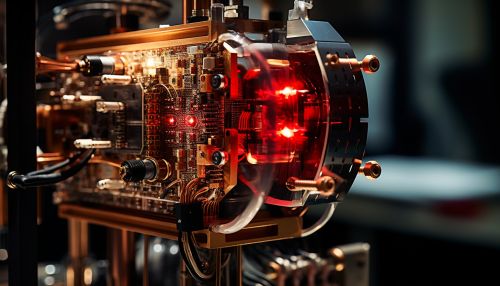Quantum Computing with Quantum Optomechanical Systems under Quantum Optics
Introduction
Quantum computing is a rapidly evolving field that leverages the principles of quantum mechanics to process information. Quantum optomechanical systems, a subset of quantum computing, utilize the interaction of light with mechanical motion to achieve quantum-level control. This article delves into the intricacies of quantum computing with quantum optomechanical systems under the lens of quantum optics, a branch of physics that studies the behavior of light and its interaction with matter at the quantum level.


Quantum Computing
Quantum computing is a computational paradigm that harnesses the unique properties of quantum bits, or qubits, to perform complex calculations at speeds unattainable by traditional computers. Unlike classical bits that can be either 0 or 1, qubits can exist in a superposition of states, enabling them to process a vast amount of information simultaneously. Quantum computers leverage quantum phenomena such as superposition and entanglement to perform computations.
Quantum Optomechanical Systems
Quantum optomechanical systems are devices that exploit the interaction between light and mechanical motion at the quantum level to achieve precise control over quantum states. These systems typically consist of a mechanical oscillator, such as a vibrating membrane or a nanomechanical resonator, coupled to an optical cavity. The interaction between the mechanical oscillator and the light field in the cavity gives rise to a variety of quantum phenomena, including cooling, squeezing, and entanglement, which can be harnessed for quantum information processing.
Quantum Optics
Quantum optics is a branch of physics that studies the behavior of light and its interaction with matter at the quantum level. It encompasses a wide range of phenomena, including the generation and detection of single photons, the manipulation of quantum states of light, and the interaction of light with quantum systems. Quantum optics plays a crucial role in quantum computing, as it provides the theoretical and experimental tools necessary to manipulate and control quantum states of light, which are essential for the operation of quantum optomechanical systems.
Quantum Computing with Quantum Optomechanical Systems
Quantum optomechanical systems offer a promising platform for quantum computing. The ability to control mechanical motion at the quantum level opens up new possibilities for quantum information processing. For instance, the mechanical oscillator in a quantum optomechanical system can be used as a quantum memory, storing quantum information in its vibrational states. Furthermore, the interaction between the mechanical oscillator and the light field in the optical cavity can be exploited to perform quantum gates, the basic building blocks of a quantum computer.
Challenges and Future Directions
Despite the promising potential of quantum optomechanical systems for quantum computing, several challenges need to be addressed. These include the need for better control over the mechanical and optical components of the system, the need for higher efficiency in the transfer of quantum information between the mechanical and optical domains, and the need for robust error correction mechanisms to protect against decoherence. Overcoming these challenges will require advances in both theory and experiment, and will likely involve the development of new materials, devices, and techniques.
